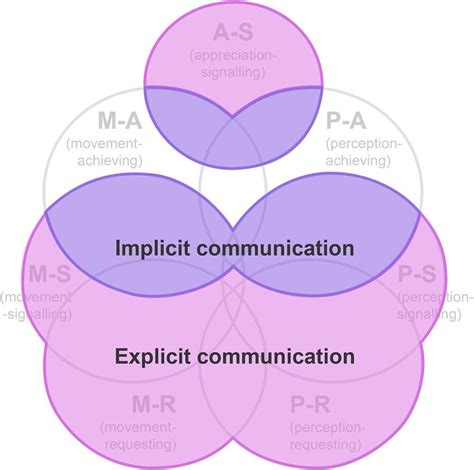Communication is the foundation of human interaction, enabling us to convey our thoughts, emotions, and ideas. It encompasses both explicit and implicit elements, each playing a crucial role in shaping our understanding of messages. This comprehensive guide delves into the explicit and implicit aspects of communication, providing insights into their significance and practical strategies for effective use.

Explicit Communication: The Obvious Layer
Explicit communication refers to the direct and literal transmission of information. It is characterized by straightforward language, clear meanings, and intentional messaging. Words, gestures, and symbols are the primary means through which explicit communication is conveyed.
Key Characteristics:
- Directness: Explicit communication conveys messages without ambiguity or hidden meanings.
- Clarity: The intended message is communicated clearly and precisely, leaving no room for misinterpretation.
- Objectivity: Explicit communication focuses on factual information, avoiding emotional language or subjective opinions.
Benefits:
- Accuracy: Explicit communication ensures that messages are conveyed accurately, reducing the risk of misunderstandings.
- Efficiency: Direct and concise language allows for efficient information exchange.
- Transparency: Explicit communication promotes transparency and accountability, as messages are easily understood and verifiable.
Implicit Communication: The Subtle Undertones
Implicit communication, on the other hand, encompasses the nonverbal cues, unspoken expectations, and cultural norms that accompany explicit language. It is a subtle form of communication that conveys meaning through indirect suggestions, gestures, and emotional overtones.
Key Characteristics:
- Nonverbal Cues: Body language, facial expressions, and tone of voice convey implicit messages.
- Shared Assumptions: Implicit communication relies on shared cultural knowledge, beliefs, and social norms.
- Contextual Dependence: The meaning of implicit communication is highly influenced by the context in which it occurs.
Benefits:
- Emotional Expression: Implicit communication allows us to convey emotions and attitudes that may be difficult to express verbally.
- Relationship Building: Shared implicit understanding fosters rapport and reinforces group identity.
- Cultural Sensitivity: Implicit communication helps us navigate cultural differences and communicate effectively with people from diverse backgrounds.
Striking a Balance
Effective communication requires a harmonious balance between explicit and implicit elements. Explicit communication provides the factual basis for messages, while implicit communication adds depth, nuance, and emotional resonance. Here are some strategies for striking the right balance:
- Use Explicit Language for Clarity: When conveying important information or instructions, use direct and precise language to avoid misinterpretations.
- Incorporate Nonverbal Cues: Pay attention to your body language, tone of voice, and facial expressions, as they convey implicit messages that can reinforce or contradict your words.
- Consider Cultural Context: Be mindful of the cultural norms and expectations that shape implicit communication in different settings.
- Practice Active Listening: Pay close attention to both the explicit and implicit messages conveyed by others.
Common Mistakes to Avoid
- Overreliance on Explicit Communication: Avoid conveying all information explicitly, as it can make communication dry and impersonal.
- Lack of Nonverbal Awareness: Fail to recognize the power of nonverbal cues, which can undermine the impact of your message.
- Cultural Misunderstandings: Assume that implicit communication is universally understood, leading to misinterpretations when dealing with people from different cultural backgrounds.
Tips and Tricks
- Use “I” Statements: Express your thoughts and feelings directly using “I” statements to avoid sounding accusatory or confrontational.
- Ask Open-Ended Questions: Encourage others to elaborate on their thoughts by asking open-ended questions that invite detailed responses.
- Use Reflective Listening: Repeat and paraphrase what others say to demonstrate that you are actively listening and understanding their perspective.
- Create a Conducive Environment: Establish a comfortable and supportive environment that allows for open communication and the sharing of both explicit and implicit messages.
Applications Across Industries
The principles of explicit and implicit communication find application in a wide range of industries:
- Healthcare: Healthcare professionals use explicit language to convey medical information and implicit communication to build rapport and provide emotional support to patients.
- Education: Explicit communication is essential for delivering instruction, while implicit communication fosters a positive learning environment and encourages student engagement.
- Business: Explicit communication facilitates clear communication of goals and expectations, while implicit communication helps build trust and collaboration within teams.
- Marketing: Explicit messaging conveys product features and benefits, while implicit communication creates emotional connections and influences consumer behavior.
Conclusion
Explicit and implicit communication are intertwined components that contribute to effective and meaningful communication. By understanding the nature of each type of communication, its benefits, and the strategies for striking a balance, we can enhance our ability to convey our ideas clearly, build strong relationships, and navigate interpersonal interactions with ease. Remember, communication is a two-way street, and effective communication involves both sending and receiving messages with attention to both explicit and implicit cues.
